My fuel additives cover gasoline, E85, and diesel. They are based on various naphtha products, diesel, acetone, alcohols, IPA, and
even water (for E85). They are carefully tested chemical constellations that work. Fuel additives for gasoline are AT, D66, A40, and ISO, while the additives for
E85 are AT, AG, and T66. ISO can be seen as a universal additive but is best suited for diesel.
A typical scenario is those who own a gasoline-powered vehicle but wish to switch to E85. After a long period of using gasoline, deposits form in the fuel system. These are residues of heavier oils that gasoline de facto contains, but in very small quantities. Over time, however, these bitumen substances build up a layer that makes fuel transportation more difficult. If you change fuel to E85, the ethanol partially dissolves the deposits, and the vehicle stops. If you know that there are deposits, you should first consider a mechanical cleaning with degreasing / white spirit, water, and compressed air - otherwise, you can dose abundantly with D66. When I developed D66, A40, G14a, T66, etc. in the year 2010, I could state that they were opening time reducing (power-increasing). This is not the case today - gasoline and E85 have been modernized so that they now develop higher power and reduce fuel consumption - without any fuel additives being added (this was stated in the summer of 2022 after several test drives with my measuring car). We talking long-acting effects!
I have no knowledge of what is behind these changes or which chemicals are involved. However, I have noticed that the lubricity of the fuel is still deficient, so it is a good idea to continue with some kind of lubricating additive. D66/T66 or AT can be added to both gasoline and E85 without affecting the fuel's inherent consumption-reducing properties. Acetone- and glycol-based additives such as AT, AG, A40, or any of my other developed opening-reducing fuel additives thus have no effect on today's gas or E85. The percentage opening time reduction data that can still be read in the description for each additive only applies if the commercial fuel has not been modified - for example if the E85 only consisted of ethanol, gasoline, and MTBE...
A typical scenario is those who own a gasoline-powered vehicle but wish to switch to E85. After a long period of using gasoline, deposits form in the fuel system. These are residues of heavier oils that gasoline de facto contains, but in very small quantities. Over time, however, these bitumen substances build up a layer that makes fuel transportation more difficult. If you change fuel to E85, the ethanol partially dissolves the deposits, and the vehicle stops. If you know that there are deposits, you should first consider a mechanical cleaning with degreasing / white spirit, water, and compressed air - otherwise, you can dose abundantly with D66. When I developed D66, A40, G14a, T66, etc. in the year 2010, I could state that they were opening time reducing (power-increasing). This is not the case today - gasoline and E85 have been modernized so that they now develop higher power and reduce fuel consumption - without any fuel additives being added (this was stated in the summer of 2022 after several test drives with my measuring car). We talking long-acting effects!
I have no knowledge of what is behind these changes or which chemicals are involved. However, I have noticed that the lubricity of the fuel is still deficient, so it is a good idea to continue with some kind of lubricating additive. D66/T66 or AT can be added to both gasoline and E85 without affecting the fuel's inherent consumption-reducing properties. Acetone- and glycol-based additives such as AT, AG, A40, or any of my other developed opening-reducing fuel additives thus have no effect on today's gas or E85. The percentage opening time reduction data that can still be read in the description for each additive only applies if the commercial fuel has not been modified - for example if the E85 only consisted of ethanol, gasoline, and MTBE...
Apart from a certain opening-time reduction (increment of power) seems the additives, cleaning, lubricating, water-absorbent, and for diesel, both cleaning and bactericidal.
The power increase does not depend on that the energy in the fuel has increased but that the burning has become more efficient and faster.
The procedure for preparation is to first determine the amount of an additive that is desired, then multiply the amount with - the component through the “sum”. For instance, suppose we want to have 900 ml of T66 - then one can prepare 600 ml of lighter fluid first (900 x 2/3). The following components are calculated the same way. To determine the amount of diesel for the same example; take 900 x 1/3 which is 300 ml of diesel.
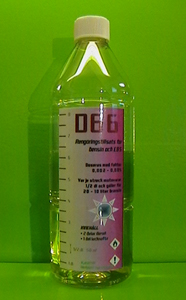 |
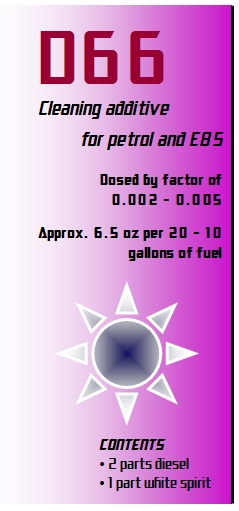 |
||
For both gasoline and E85. Power enhancing and cleans/lubricates the fuel system. |
|||
Dose factor: 0.002 - 0.005 |
0.2 - 0.5 % |
||
2 parts diesel (city diesel/ACP) 1 part white spirit sum = 3 parts |
|||
Commentary |
|||
For glycol-based additives works D66 excellent but with no other additives makes D66 great use. Eg a petrol car that runs with D66 will soon begin to show
positive characteristics such as smoother running and more engine power. See the site about X66 for more
information. |
|||
Consumption gain: Not measured |
|||
Opening time reduction: 25-30 % |
|||
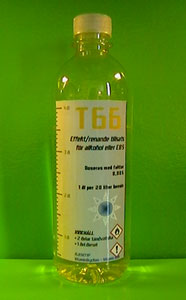 |
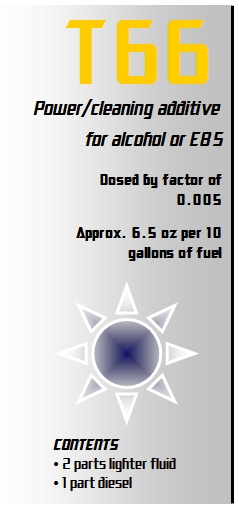 |
||
Only for E85. Power enhancing and cleans/lubricates the fuel system. |
|||
Dose factor: 0.005 |
0.5 % |
||
2 parts lighter fluid (hydrogen treated naphtha) 1 part diesel - avoid ACP! (Preem) sum = 3 parts |
|||
Commentary |
|||
Protect T66 from UV radiation that otherwise breaks down the lighter fluid. Some lighter fluids and diesel do not work. Choose a white spirit-based,
non-paraffin-based lighter fluid (environmental option). Thus, lighter fluid and diesel from mineral oil. |
|||
Consumption gain: 2-5 % |
|||
Opening time reduction: 30-40 % |
|||
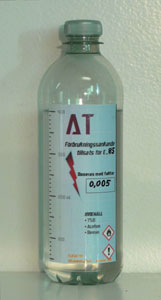 |
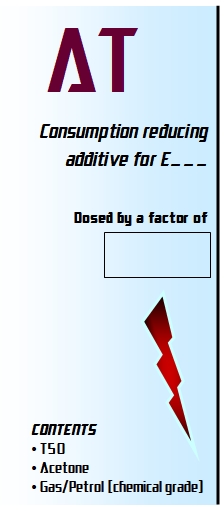 |
||
For gasoline, E85 and mixtures of gas and ethanol fuels. Cleans and lubricates the fuel system. |
|||
The dosing factor varies - type value 0.005 |
|||
|
|||
Commentary |
|||
Adapted Tandvatska. Protect AT from UV radiation that otherwise breaks down the lighter fluid. “T50” consists of equal parts lighter fluid and lamp kerosene.
“Petrol” can be chemically pure petrol or alkylate petrol (Aspen Fuel). The ingredients must be calculated depending on the ethanol content of the fuel and
the amount of the additive - use the Javapump below! Can be used alone. |
|||
Consumption gain: Not measured |
|||
Opening time reduction: Not measured |
|||
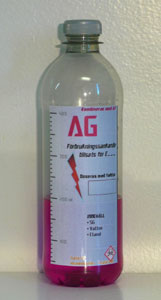 |
Complement to AT |
 |
|
For E85 and mixtures of gasoline and ethanol fuels. Consumption lowering glycol-based additive. |
|||
The dosing factor varies - type value 0.005 |
|||
|
|||
Commentary |
|||
Adapted Glycol. Together with AT will AG provides a reduction in consumption that decreases with decreasing ethanol content. AG should be dosed after dosing AT,
then you can let everything mix for at least three minutes. “SG” stands for Special Glycol and is glycol of the type G30 with HTMA powder
(Hexamethyleneteteramine, Hexamine). “Water” can be deionized water. “Ethanol” can be bioethanol. Bioethanol is usually free of IPA (isopropyl alcohol),
which is positive. IPA and IBA have the ability to poison the fuel or reduce the consumption-saving effect of the additive. The ingredients must be calculated
depending on the ethanol content of the fuel and the amount of the additive - use the Javapump below! |
|||
Consumption gain: Not measured |
|||
Opening time reduction: Not measured |
|||
 |
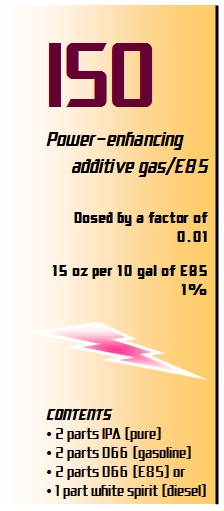 |
||
For both gasoline and E85 and also for DIESEL. |
|||
Dose factor: 0.01 |
1 % |
||
2 parts IPA (pure) 2 parts D66 for both gasoline or E85 1 part white spirit (only for diesel fuels) sum = 4 parts (3 parts for diesel) |
|||
Commentary |
|||
Along with a cleaning and lubricating component increases not only the power but also the fuel consumption should decrease. ISO can be seen as a Tripak
substitute. Select either D66 or white spirit (not both). |
|||
Consumption gain: Not measured |
|||
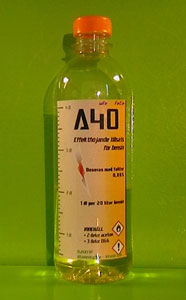 |
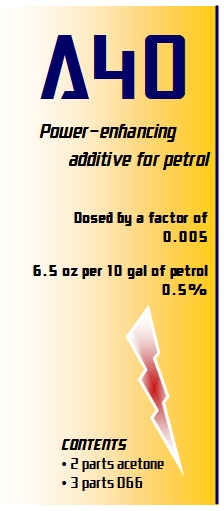 |
||
For gasoline. |
|||
Dose factor: 0.005 |
0.5 % |
||
2 parts acetone 3 parts D66 sum = 5 parts |
|||
Commentary |
|||
This additive is especially suitable for gasoline cars! Acetone plus a cleaning and lubricating component leads to increased power and lower fuel consumption.
The amount of acetone is now 0.2%. To reduce the level of acetone; try with 3/5 (0.19%) or 4/7 (0.18%) instead of 2/3 (0.2). |
|||
Consumption gain: 2-5 % |
|||
Opening time reduction: -10 % |
|||
 |
|||
For all fuels. Power enhancing and decrease consumption. |
|||
Dose factor: 0.01 in pure petrol |
1 % |
||
| For 10 gallons petrol dosed 15 oz For 10 gallons E85 dosed 3 oz |
|||
Commentary |
|||
IPA is temperature sensitive but can be added as a sub component. Bactericidal function in diesel. See the site about IPA for further information. |
|||
Consumption gain: Not measured |
|||
 |
|||
For both gasoline and E85. Power enhancing and decrease consumption. |
|||
Dose factor: 0.0018 in pure petrol |
0.18 % |
||
For 10 gallons E85 dosed 0.35 oz For 10 gallons E60 dosed 0.92 oz For 10 gallons E55 dosed 1.04 oz For 10 gallons E45 dosed 1.27 oz For 10 gallons E05 dosed 2.19 oz |
For 10 gallons pure petrol: 2.30 oz |
||
Commentary |
|||
Has major positive impact and added as a sub component. See the site about acetone for further information. |
|||
Consumption gain: 5-10 % (petrol fuels) |
|||
|
| |
|
| |






